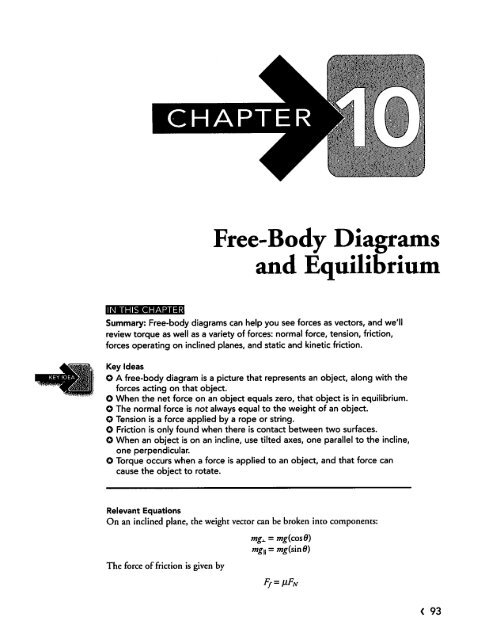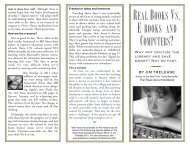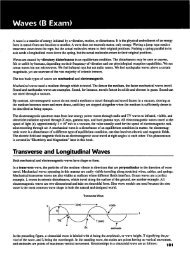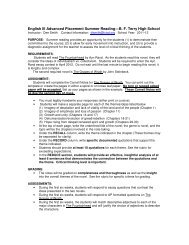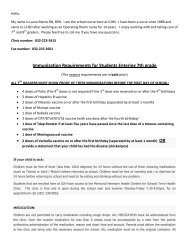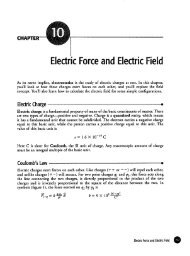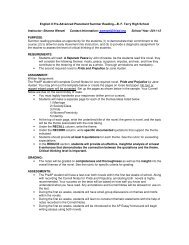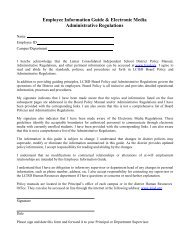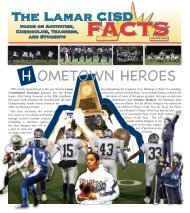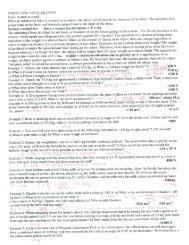You also want an ePaper? Increase the reach of your titles
YUMPU automatically turns print PDFs into web optimized ePapers that Google loves.
!'■'.-■." K?:.."'..". ;■"■. ■.■■ ■:■■■■•'■■■■:<br />
■■■...■ ..'.;"■ "
94 > Review the Knowledge You Need to Score High<br />
Physics, at its essence, is all about simplification. The universe is a complicated place, <strong>and</strong><br />
if you want to make sense of it—which is what physicists try to do—you need to reduce it<br />
to some simplified representation: for example, with free-body diagrams.<br />
We will refer regularly to forces. A force refers to a push or a pull applied to an object.<br />
Something can experience many different forces simultaneously—for example, you can<br />
push a block forward while friction pulls it backward, but the net force is the vector sum<br />
of all of the individual forces acting on the block.<br />
Net Force: The vector sum of all the forces acting on an object.<br />
What Is a <strong>Free</strong>-<strong>Body</strong> Diagram?<br />
A free-body diagram is a picture that represents one or more objects, along with the forces<br />
acting on those objects. The objects are almost always drawn as rectangles or circles, just for<br />
the sake of simplicity, <strong>and</strong> the forces are always shown as vectors. Figure 10.1 shows a few<br />
examples.<br />
<strong>Free</strong>-body diagrams are important because they help us to see forces as vectors. And if<br />
you can add vectors, you can analyze a free-body diagram. (If you can't add vectors, you<br />
didn't read Chapter 9 carefully enough.)<br />
Let's look at the two examples in Figure 10.1. In the first, a force is directed down.<br />
This force, which is the force of gravity, was labeled in the diagram as "weight." The force<br />
of gravity on the hippo (that is, the hippo's weight) pulls downward. In the second<br />
example, a force is directed to the right. The pineapple is being pulled by a rope to<br />
the right.<br />
Weight: The force due to gravity, equal to the mass of an object times g, the gravitational<br />
field (about 10 N/kg on Earth).<br />
A hippopotamus<br />
falling in the<br />
absence of air<br />
resistance<br />
weight<br />
A large pineapple<br />
being pulled by a<br />
string while floating in<br />
outer space<br />
tension<br />
Figure 10.1 Two examples of free-body diagrams.<br />
As you see, there is no need to be artistic on the AP exam.
<strong>Free</strong>-<strong>Body</strong> <strong>Diagrams</strong> <strong>and</strong> <strong>Equilibrium</strong> < 95<br />
You'll often see weight abbreviated as mg. Just be careful that the mass you use is in<br />
kilograms.<br />
For the rest of this chapter, we focus on objects in equilibrium.<br />
<strong>Equilibrium</strong><br />
When the net force on an object equals zero, that object is in equilibrium. At equilibrium,<br />
an object is either at rest or moving with a constant velocity, but it is not accelerating.<br />
You've heard of Newton's first law, of course: an object maintains its velocity unless<br />
acted upon by a net force. Well, an object in equilibrium is obeying Newton's first law.<br />
How to Solve <strong>Equilibrium</strong> Problems<br />
We have a tried-<strong>and</strong>-true method. Follow it every time you see an equilibrium situation.<br />
1. Draw a proper free-body diagram.<br />
2. Resolve force vectors into x- <strong>and</strong>/-components, if necessary.<br />
3. Write an expression for the vector sum of the left-right forces. Then write an expres<br />
sion for the vector sum of the up-down forces. Set each of these expressions equal to<br />
zero.<br />
4. Solve the resulting algebraic equations.<br />
A Brief Interlude: UNITS!<br />
Before we lose ourselves in the excitement of free-body diagrams, we need to pay tribute to<br />
the unit of force: the newton. One N (as newtons are abbreviated) equals one kg-m/s2. We<br />
discuss why 1 newton equals 1 kg-m/s2 in a future chapter. For now, let it suffice that any<br />
force can be measured in newtons.<br />
A Really Simple <strong>Equilibrium</strong> Problem<br />
For those of you who prefer to splash your toes in the metaphorical swimming pool of<br />
physics before getting all the way in, this section is for you. Look at this situation:<br />
Two astronauts tug on opposite sides of a satellite. The first astronaut tugs to the left<br />
with a force of 30 N. With what force does the second astronaut tug in order to keep<br />
the satellite at rest?<br />
The solution to this problem is painfully obvious, but we'll go through the steps just to be<br />
thorough.<br />
Step 1: Draw a proper free-body diagram.<br />
astronaut 1 ' astronaul 2<br />
We can skip Step 2 because these vectors already line up with each other, so they do not<br />
need to be resolved into components.
96 > Review the Knowledge You Need to Score High<br />
Step 3: Write expressions for the vector sums.<br />
This problem only involves left-right forces, so we only need one expression. Because we<br />
have an equilibrium situation, the net force is ZERO:<br />
Step 4: Solve.<br />
F2 - (30 N) = 0<br />
F2 = 30 N<br />
Very good. Now, lets see how closely you were paying attention. Here's the same<br />
problem, with a slightly different twist.<br />
Two astronauts tug on opposite sides of a satellite. The first astronaut tugs to the left<br />
with a force of 30 N. With what force does the second astronaut tug in order to keep<br />
the satellite moving toward him at a constant speed of 20 m/s?<br />
Think for a moment. Does the second astronaut have to apply more, less, or the same force<br />
as compared to the previous problem?<br />
The second astronaut applies exactly the sameforce as in the previous problem! An object<br />
moving with constant velocity is in equilibrium, just as if the object were still. This is a cen<br />
tral concept in Newtonian mechanics.<br />
Normal<br />
Force<br />
Let's return to Earth for a moment.<br />
weight<br />
Figure 10.2<br />
In Figure 10.2, a box is sitting on a table. The force of gravity pulls downward (as with the<br />
hippo, we've labeled this force "weight"). We know from experience that boxes sitting on<br />
tables do not accelerate downward; they remain where they are. Some force must oppose<br />
the downward pull of gravity.<br />
This force is called the normal force,1 <strong>and</strong> it is abbreviated FN. In fact, whenever you<br />
push on a hard surface, that surface pushes back on you—it exerts a normal force. So, when<br />
you st<strong>and</strong> on the floor, the floor pushes up on you with the same amount of force with<br />
which gravity pulls you down, <strong>and</strong>, as a result, you don't fall through the floor.<br />
Normal Force: A force that acts perpendicular to the surface on which an object rests.<br />
'When physicists say "normal," they mean "perpendicular." The word "normal" in its conventional meaning simply does<br />
not apply to physicists.
<strong>Free</strong>-<strong>Body</strong> <strong>Diagrams</strong> <strong>and</strong> <strong>Equilibrium</strong> < 97<br />
The normal force is not always equal to the weight of an object! Think about this before we<br />
get to the practice problems.<br />
Tension<br />
Tension is a force applied by a rope or string. Here are two of our favorite tension prob<br />
lems. The first is super easy, but a good introduction to tension; the second is more<br />
involved.<br />
A box has a mass of 5 kg <strong>and</strong> is hung from the ceiling by a rope. What is the tension<br />
in the rope?<br />
\<br />
s kg<br />
Step 1: <strong>Free</strong>-body diagram.<br />
"■ T<br />
Step 2: Vector components.<br />
Hey! These vectors already line up. On to Step 3.<br />
Step 3: Equations.<br />
Remember, weight is equal to mass times the gravitational field, or mg.<br />
Fnet,.y= T-mg=0<br />
T- (5 kg) (10 N/kg) = 0<br />
Step 4: Solve.<br />
T=50N
98 > Review the Knowledge You Need to Score High<br />
The same box is now hung by two ropes. One makes a 45-degree angle with the ceiling;<br />
the other makes a 30-degree angle with the ceiling. What is the tension in each rope?<br />
30°<br />
5 kg<br />
Step 1: <strong>Free</strong>-body diagram.<br />
weight<br />
Step 2: Vector components.<br />
1 t<br />
T2y<br />
. f weight<br />
Step 3: Equations.<br />
Let's start with the x-direction.<br />
And from vector analysis we know that<br />
TXx= r,(cos 30°) <strong>and</strong> 7^= r2(cos 45°).<br />
so,<br />
r,(cos 30°) - 7"2(cos 45°) = 0.<br />
<strong>Free</strong>-<strong>Body</strong> <strong>Diagrams</strong> <strong>and</strong> <strong>Equilibrium</strong> < 99<br />
so,<br />
r,(sin 30°) + 72(sin 45°) - (50 N) = 0. is equation (Eg. 2)<br />
Step 4: Solve.<br />
We can solve Equation 1 <strong>and</strong> Equation 2 simultaneously <strong>and</strong> find Tx <strong>and</strong> T2. We'll let you do<br />
this on your own,2 but in case you want to check your answers, 7"i = 37 N <strong>and</strong> T2 = 45 N.<br />
(These are reasonable answers, as the tension in each rope is the same power of 10 as the<br />
50 N weight of the box.)<br />
Steps 1, 2, <strong>and</strong> 3 are the important steps. Step 4 only involves math. "ONLY math?!?"<br />
you ask, incredulous. That's the toughest part!<br />
Well, maybe for some people. Getting the actual correct answer does depend on your alge<br />
bra skills. But, <strong>and</strong> this is important, this is AP Physics, NOTAP Algebra. The graders of the AP<br />
exam will assign most of the credit just for setting up the problem correaly! If you're stuck on<br />
the algebra, skip it! Come up with a reasonable answer for the tensions, <strong>and</strong> move on!<br />
We're not kidding. Look at Chapter 7, which discusses approaches to the free-response<br />
section, for more about the relative importance of algebra.<br />
Friction<br />
Friction is only found when there is contact between two surfaces.<br />
Friction: A force acting parallel to two surfaces in contact. If an object moves, the<br />
friction force always acts opposite the direction of motion.<br />
For example, let's say you slide a book at a constant speed across a table. The book is in con<br />
tact with the table, <strong>and</strong>, assuming your table isn't frictionless, the table will exert a<br />
friction force on the book opposite its direction of motion. Figure 10.3 shows a free-body<br />
diagram of that situation.<br />
I<br />
weight<br />
Figure 10.3<br />
<strong>Free</strong>-body diagram of a book sliding on a table.<br />
■Try solving (he x-axis equation for 7",, then plug that into tlic^-axis equation:<br />
T,=T2<br />
cos 45"<br />
cos 30<br />
cos 45"<br />
cos 30°<br />
sin 30° + (t2 sin 45°) - (50 n) = 0<br />
Plug in the value of cos 45 , cos 30 , sin 30 , sin 45 ... <strong>and</strong> now it's easy to solve for 1" = 45 N.
100 > Review the Knowledge You Need to Score High<br />
We know that because the book represented in Figure 10.3 is not being shoved through the<br />
table or flying off it, FN must equal the book's weight. And because the book moves at con<br />
stant velocity, the force you exert by pushing the book, Fpui^, equals the force of friction, Ff.<br />
Remember, being in equilibrium does not necessarily mean that the book is at rest. It could be<br />
moving at a constant velocity.<br />
How do we find the magnitude of FA<br />
r=H-rN<br />
Mu (fi) is the coefficient of friction. This is a dimensionless number (tiiat is, it doesn't have any<br />
units) that describes how big die force of friction is between two objects. It is found experimen<br />
tally because it differs for every combination of materials (for example, if a wood block slides<br />
on a glass surface), but it will usually be given in AP problems diat involve friction.<br />
And if fl isn't given, it is easy enough to solve for—just rearrange the equation for \i<br />
algebraically:<br />
Remember, when solving for Ff, do not assume that FN equals the weight of the object in<br />
question. Here's a problem where this reminder comes in h<strong>and</strong>y:<br />
A floor buffer consists of a heavy base (m = 15 kg) attached to a very light h<strong>and</strong>le.<br />
A worker pushes the buffer by exerting a force P directly down the length of the<br />
h<strong>and</strong>le. If the coefficient of friction between the buffer <strong>and</strong> the floor is ft = 0.36,<br />
what is the magnitude of the force P needed to keep the buffer moving at<br />
a constant velocity?<br />
ft = 0.36<br />
The free-body diagram looks like this:<br />
I<br />
mg<br />
Exam tip from an AP Physics veteran:<br />
When drawing a free-body diagram, put the tail of the force vectors on the object, with<br />
the arrow pointing away from the object. Never draw a force vector pointing into an<br />
object, even when something is pushing, as with the P force in this example.<br />
—Chris, high schooljunior
<strong>Free</strong>-<strong>Body</strong> <strong>Diagrams</strong> <strong>and</strong> <strong>Equilibrium</strong> < 101<br />
Now, in the vertical direction, there are three forces acting: /"jv acts up; weight <strong>and</strong> the ver<br />
tical component of/" act down.<br />
1<br />
mg<br />
Notice that when we set up the equilibrium equation in the vertical direction, FN —<br />
(mg + Py) = 0, we find that F^ is greater than mg.<br />
Let's finish solving this problem together. We've already drawn the vertical forces acting<br />
on the buffer, so we just need to add the horizontal forces to get a complete free-body dia<br />
gram with the forces broken up into their components (Steps 1 <strong>and</strong> 2):<br />
i<br />
FN<br />
mg<br />
Step 3 calls for us to write equations for the vertical <strong>and</strong> horizontal directions. We already<br />
found the equilibrium equation for the vertical forces,<br />
FN-(mg+P,) = 0y<br />
<strong>and</strong> it's easy enough to find the equation for the horizontal forces,<br />
Ff-Px=0.<br />
To solve this system of equations (Step 4), we can reduce the number of variables with a<br />
few substitutions. For example, we can rewrite the equation for the horizontal forces as<br />
H-FN-P-cos 37° = 0.<br />
Furthermore, we can use die vertical equation to substitute for FN,<br />
FN=mg+P-sin 37°.<br />
Plugging this expression for FN into the rewritten equation for the horizontal forces, <strong>and</strong><br />
then replacing the variables m, g, <strong>and</strong> /I with their numerical values, we can solve for P. The<br />
answer is P = 93 N.<br />
Static <strong>and</strong> Kinetic Friction<br />
You may have learned that the coefficient of friction takes two forms: static <strong>and</strong> kinetic<br />
friction. Use die coefficient of static friction if something is stationary, <strong>and</strong> the coefficient<br />
of kinetic friction if the object is moving. The equation for the force of friction is essentially<br />
the same in either case: Ff= flFN.
102 > Review the Knowledge You Need to Score High<br />
The only strange part about static friction is that the coefficient of static friction is a<br />
maximum value. Think about this for a moment... if a book just sits on a table, it doesn't<br />
need any friction to stay in place. But that book won't slide if you apply a very small hori<br />
zontal pushing force to it, so static friction can act on the book. To find the maximum coef<br />
ficient of static friction, find out how much horizontal pushing force will just barely cause<br />
the book to move; then use Ff = [lFN.<br />
Inclined<br />
Planes<br />
These could be the most popular physics problems around. You've probably seen way<br />
too many of these already in your physics class, so we'll just give you a few tips on approach<br />
ing diem.<br />
9<br />
Figure 10.4<br />
Generic inclined-plane situation.<br />
In Figure 10.4 we have a block of mass m resting on a plane elevated an angle 6 above the<br />
horizontal. The plane is not friaionless. We've drawn a free-body diagram of the forces<br />
acting on die block in Figure 10.5a.<br />
weight<br />
Figure 10.5a Forces acting on the block in Figure 10.4.<br />
Ff is directed parallel to the surface of the plane, <strong>and</strong> FN is, by definition, directed perpen<br />
dicular to the plane. It would be a pain to break these two forces into x- <strong>and</strong> ^components,<br />
so instead we will break the "weight" vector into components that "line up" with Ff <strong>and</strong><br />
FN, as shown in Figure 10.5b.<br />
mg(s\n 0)<br />
mg(cos 6)<br />
Figure 10.5b Forces acting on the block in Figure 10.4, with the weight vector<br />
resolved into components that line up with the friction force <strong>and</strong> the normal force.
<strong>Free</strong>-<strong>Body</strong> <strong>Diagrams</strong> <strong>and</strong> <strong>Equilibrium</strong> < 103<br />
Memorize this<br />
As a rule ofthumb, in virtually all inclined-plane problems, you can always break the weight<br />
vector into components parallel <strong>and</strong> perpendicular to the plane, WHERE THE COMPO<br />
NENT PARALLEL TO (POINTING DOWN) THE PLANE = mg(sin B) AND THE<br />
COMPONENT PERPENDICULAR TO THE PLANE= mg(cos G).<br />
This rule always works, as long as die angle of the plane is measured from the horizontal.<br />
Torque<br />
Torque occurs when a force is applied to an objea, <strong>and</strong> diat force can cause the objea to rotate.<br />
Torque = Fd<br />
In other words, the torque exerted on an object equals the force exerted on that object<br />
(F) multiplied by the distance between where the force is applied <strong>and</strong> the fulcrum (d) as<br />
long as the force acts perpendicular to the object.<br />
Fulcrum: The point about which an object rotates<br />
Figure 10.6 shows what we mean:<br />
fulcrum<br />
Figure 10.6 The torque applied to this bar equals FtL<br />
The unit of torque is the newton-meter.<br />
Torque problems on the AP Physics B exam tend to be pretty straightforward. To solve<br />
them, set counterclockwise torques equal to clockwise torques.<br />
Here's an example.<br />
Bob is st<strong>and</strong>ing on a bridge. The bridge itself weighs 10,000 N. The span between<br />
pillars A <strong>and</strong> B is 80 m. Bob is 20 m from the center of the bridge. His mass is 100 kg.<br />
Assuming that the bridge is in equilibrium, find the force exerted by pillar B on the<br />
bridge.<br />
Bob<br />
B
104 > Review the Knowledge You Need to Score High<br />
Step I: <strong>Free</strong>-body diagram.<br />
We'll use point A as die fulcrum to start with. Why? In a static equilbrium situation, since die<br />
bridge isn't actually rotating, any point on die bridge could serve as a fulcrum. But we have two<br />
unknown forces here, die forces of die supports A <strong>and</strong> B. We choose die location of one of these<br />
supports as die fulcrum, because now that support provides zero torque—die distance from die<br />
fulcrum becomes zero! Now all we have to do is solve for die force of support B.<br />
The diagram below isn't a true "free-body diagram," because it includes both distance<br />
<strong>and</strong> forces, but it is useful for a torque problem. Bob's weight acts downward right where<br />
he st<strong>and</strong>s. The bridges weight is taken into account with a force vector acting at the bridge's<br />
center of mass; that is, 40 m to the right of pillar A.<br />
80 m<br />
20 m<br />
Step 2: Vector components.<br />
We don't have to worry about vector components here. (We would have if the forces had<br />
not acted perpendicular to the bridge. Such a situation is much more likely to appear on<br />
the C than the B exam—see the Physics C section below.)<br />
Step 3: Equations.<br />
Torquenel = counterclockwise - clockwise = 0.<br />
(FB)(80 m) - [(100 kg-10 N/kg)(20 m) + (10,000 N)(40 m)] = 0.<br />
Step 4: Solve. ^=5300 N<br />
This is reasonable because pillar B is supporting less than half of the 11,000 N weight of the<br />
bridge <strong>and</strong> Bob. Because Bob is closer to pillar A, <strong>and</strong> orherwise the bridge is symmetric,<br />
A should bear the majority of the weight.<br />
Of Special Interest to Physics C Students<br />
It must be emphasized that even Physics C students must go through the four-step<br />
problem-solving process described in this chapter. Frequently, Physics C students try to take<br />
shortcuts, thinking that equilibrium problems are easy, only to miss something important.<br />
If free-body diagrams are good enough for professional physicists to use, they are good<br />
enough for you.<br />
The Physics C exam will often expect you to find the torque provided by a force that<br />
acts at an angle. For example, consider a force F acting on a bar at an angle 6, applied a<br />
distance x from a pivot. How much torque does this force provide? See Figure 10.7.<br />
,— Pivot<br />
/<br />
F<br />
Figure 10.7
<strong>Free</strong>-<strong>Body</strong> <strong>Diagrams</strong> <strong>and</strong> <strong>Equilibrium</strong> < 105<br />
To solve, break the force vector into horizontal <strong>and</strong> vertical components, as shown in<br />
Figure 10.8.<br />
I— Pivot<br />
n<br />
Fsmd<br />
Figure 10.8<br />
The vertical component of F applies a torque of (F sin0)*. The horizontal component of/7<br />
does not apply any torque, because it could not cause the bar to rotate. So, the total torque<br />
provided by F\s (Fs\nd)x.<br />
Lever Arm<br />
The "lever arm" for a force is the closest distance from the fulcrum to the line of that force.<br />
Then, the torque provided by a force is the force times the lever arm.<br />
Consider Figure 10.9, which represents the same situation as does Figure 10.7. Instead<br />
of breaking F into components, continue the line of the force. The torque is F times the<br />
lever arm shown in the diagram. By trigonometry, you can see that the lever arm is equal<br />
to xsind. No matter how you look at it, the torque provided by F\s still (Fsind)x.<br />
Figure 10.9
106 > Review the Knowledge You Need to Score High<br />
> Practice Problems<br />
3. Give two examples of a situation in which the<br />
normal force on an object is less than the objects<br />
weight. Then give an example of a situation in<br />
which there is NO normal force on an object.<br />
30<br />
50 g<br />
e<br />
/i = 0.30<br />
1. A 50-g mass is hung by string as shown in the pic- 4. A 150-N box sits motionless on an inclined plane,<br />
ture above. The left-h<strong>and</strong> string is horizontal; the as shown above. What is the angle of the incline?<br />
angled string measures 30° to the horizontal. What<br />
is the tension in the angled string? ///////////<br />
6000 kg<br />
2. A 6000-kg bus sits on a 30° incline. A crane<br />
attempts to lift the bus off of the plane. The crane<br />
pulls perpendicular to the plane, as shown in the<br />
diagram. How much force must the crane apply so<br />
that the bus is suspended just above the surface?<br />
[cos 30° = 0.87, sin 30° = 0.50]<br />
(A) 52,000 N<br />
(B) 30,000 N<br />
(C)6000 N<br />
(D)5200 N<br />
(E) 300 N<br />
5. A 50-g meterstick is to be suspended by a single<br />
string. A 100-g ball hangs from the left-h<strong>and</strong><br />
edge of the meterstick. Where should the string<br />
be attached so that the meterstick hangs in<br />
equilibrium?<br />
(A) at the left-h<strong>and</strong> edge<br />
(B) 40 cm from left-h<strong>and</strong> edge<br />
(C) 30 cm from right-h<strong>and</strong> edge<br />
(D) 17 cm from left-h<strong>and</strong> edge<br />
(E) at the midpoint of the meterstick
<strong>Free</strong>-<strong>Body</strong> <strong>Diagrams</strong> <strong>and</strong> <strong>Equilibrium</strong> < 107<br />
> Solutions to Practice<br />
Problems<br />
In any situation where an object does not rest on a<br />
surface (for example, when something floats in<br />
space), there is no normal force.<br />
4. This free-body diagram should be very familiar to<br />
you by now.<br />
i.<br />
r,<br />
weight<br />
weight<br />
mg(sm 6)<br />
Call the tension in the angled rope T2. In the<br />
y-direction, we have T2,y= 7*2(sin 30°) acting up, <strong>and</strong><br />
mg acting down. Set "up" forces equal to "down"<br />
forces <strong>and</strong> solve for tension: T2 = mg/(sin 30°). Don't<br />
forget to use the mass in KILOgrams, i.e., 0.050 kg.<br />
The tension thus is (0.050 kg)(10 N/kg)/(0.5) =<br />
1.0 N. This is reasonable because the tension is about<br />
the same order of magnitude as die weight of die<br />
mass.<br />
weight<br />
mg(cos 30<br />
/ 1 mg(sm 30°)<br />
>s30°)]<br />
A—Because the force of the crane, Fc, acts perpen<br />
dicular to the plane, the parallel-to-die-plane direc<br />
tion is irrelevant. So all we need to do is set Fc equal<br />
to mg{cos 30°) = (6000 kg)(10 N/kg)(.87) <strong>and</strong><br />
plug in. Fc = 52,000 N. This is a reasonable answer<br />
because it is less than—but on the same order of<br />
magnitude as—the weight of the bus.<br />
3. When a block rests on an inclined plane, the<br />
normal force on the block is less than the blocks<br />
weight, as discussed in the answer to #2. Another<br />
example in which the normal force is less than an<br />
object's weight occurs when you pull a toy wagon.<br />
mg{cos 6)<br />
The box is in equilibrium, so Ff must equal mg<br />
(sinfl), <strong>and</strong> FN must equal 7«g-(cos0).<br />
H'FN = fl-mg(cos6) = mg(sind).<br />
Plugging in the values given in the problem we find<br />
that fl = 17°. This answer seems reasonable because<br />
we'd expect the incline to be fairly shallow.<br />
5. D—This is a torque problem, <strong>and</strong> the fulcrum is<br />
wherever die meter stick is attached to die string. We<br />
know diat the meter stick's center of mass is at die<br />
50 cm mark, so we can draw the following picture.<br />
50 -x<br />
I<br />
weighty<br />
Because the stick is in equilibrium, the clockwise<br />
torques equal the counterclockwise torques:<br />
(1 N)(x) = (0.5 N)(50 - x). So x=something in the<br />
neighborhood of 25/1.5 ~ 17 cm. This answer is<br />
less than 50 cm, <strong>and</strong> is closer to the edge with the<br />
heavy mass, so it makes sense.<br />
weight
108 > Review the Knowledge You Need to Score High<br />
> Rapid Review<br />
• A free-body diagram is a simplified representation of an object <strong>and</strong> the forces acting on it.<br />
• When the net force on an object is zero, it is in equilibrium. This means that it is either<br />
at rest or that it is moving at a constant velocity.<br />
• To solve an equilibrium problem, draw a good free-body diagram, resolve all forces into<br />
x- <strong>and</strong>/-components, <strong>and</strong> then set the vector sum of the x-components equal to zero <strong>and</strong><br />
the vector sum of the/-components equal to zero.<br />
• The units of force are newtons, where 1 N = 1 kg-m/s2.<br />
• Torque equals the force exerted on an object multiplied by the distance between where<br />
that force is applied <strong>and</strong> the fulcrum (the point about which an object can rotate). When<br />
an object is in equilibrium, the counterclockwise torques equal the clockwise torques.


